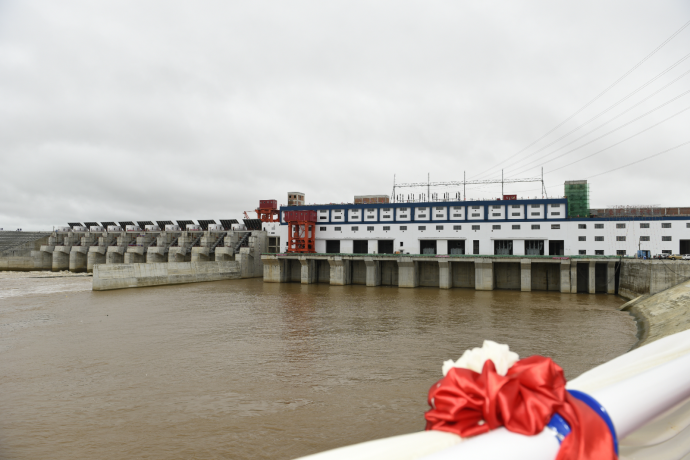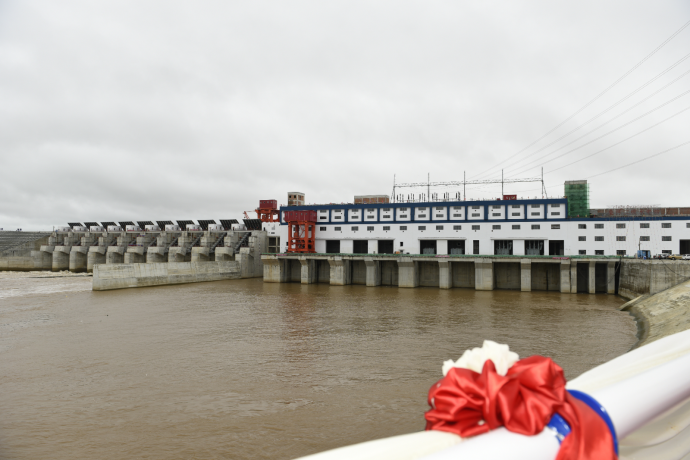
by Mao Pengfei, Nguon Sovan
STUNG TRENG, Cambodia, May 18 (Xinhua) -- Driving along National Road No. 78 here in Sesan district of Stung Treng Province in northern Cambodia, one will see orderly rows of new houses in the new Kbal Romeas village that the Lower Sesan II Hydropower Company had built for resettled villagers.
Those houses with red walls and blue roofs are boldly defined against the azure sky with drifting white clouds.
For Krav Many, a 45-year-old father of three, the new village has brought his family a convenient life because it has good roads, drainage system, clean water, low-priced electricity, school and health center, unlike the old Kbal Romeas village that had none of these.
Many, his wife and three children decided to relocate from the old village to the new one in 2015 in order to make way for the development of the 400-megawatt Sesan II hydropower dam.
The Lower Sesan II Hydropower Plant, the kingdom's biggest hydropower dam so far, started its first phase operations in November last year after almost four years of construction. The dam, 56.5 meters tall, covers a 36,000-hectare plot.
Located in northeastern Cambodia's Stung Treng province, the 781-million-U.S. dollar project is a joint venture among China's Huaneng Hydrolancang International Energy holding 51 percent of the stake, Cambodia's Royal Group owning 39 percent and Vietnamese EVN International Joint Stock Company possessing 10 percent.
At the old village, Many owned a thatched hut and four hectares of farmland, and when he agreed to resettle in the new village, the company built an 80-square-meter wooden house on the 20-meter-by-50-meter parcel of land for him, compensated him for the damage to his farm crops in the old village and the government gave another five hectares of farmland to his family.
The distance between the old and the new villages was about 70 km, he said, adding that his family made the living by growing rice, fishing and cutting wood in the old village. While in the new village, the family makes the living by growing rice, fishing and raising animals.
"Talking about monthly income, it's comparable between the old village and the new village," Many told Xinhua in a recent interview. "But we prefer the new place to the old one because the new place has good transport infrastructure, unlike the old one where the road was very poor and flooded in rainy season."
"The company has dug wells and ponds for the new village, and offered a cheaper price of electricity," he said, noting that at the old village, there was no electricity, and villagers used kerosene lamps, batteries or solar panels to light up their houses.
"The most important things are there are a public school and a free-of-charge health center near our house," he said, adding that in the old village, if someone got sick, he or she had to travel about 70 km to a health center.
For future plan, Many said if he had capital, he would expand to grow cashew trees on his farmland.
The hydropower project had affected 860 families in six villages. To date, 791 families, or 92 percent of them, have accepted compensation and relocated to new villages. Kbal Romeas village is one of them and its present location was determined by villagers' voting.
Kru You, chief of the new Kbal Romeas village, said there were some 140 families in the old Kbal Romeas village who were affected by the dam development, and 88 families of them had volunteered to resettle in the new village since 2015.
He said each resettled family received an 80-square-meter wooden or concrete house built on a 20-meter-by-50-meter piece of land, 5 hectares of farmland, cash compensation, and subsidy in the first year in the new place.
Life was tough in the old village, Kur You recalled, but villagers didn't want to leave their traditional homeland at first. Things gradually changed after they visited the new village and saw the possibilities of a better new life.
"For me, I like the new village more than the old one because in the new village, there are proper roads, sewer pipes, and pagoda, and it does not inundate in rainy season," he told Xinhua.
"In the old village in rainy season, it was very inconvenient to go outside as the earth path was always flooded by rain, while in dry season the road dust blew everywhere. Now, it changed. We are living beside National Road No. 78 with asphalt surface. There is no dust, no flooding."
He said in the new village, people earned their living by growing rice, fishing and raising animals.
"Some families have better lives because they work hard and grow crops as much as possible on their land, so their living conditions are getting better," Kru You said.
He said in the first year in the new village, the company had provided rice and food stuff to the relocated families, and agricultural experts also gave advice and techniques on growing crops.
Cambodian Prime Minister Samdech Techo Hun Sen said in September last year during an inauguration ceremony of the project that in the country's history, the northeastern region, including Stung Treng, Kratie, Ratanakkiri and Mondolkiri provinces, had relied on electricity mainly imported from Laos.
"But from now on, residents in these provinces will have access to long-term and reliable electricity with cheap prices," he said.
Kru You also has a new plan. His family has grown rice paddy on three of his five-hectare land and he plans to expand to grow cashew trees and mango trees when he saves enough money.
In the new village near the national road, farmers don't need to worry over market because middlemen always approached the village for buying their agricultural products, Kru You said.
When the sky went dark, windows of new houses in the new Kbal Romeas village lighted up one by one. In the remotest area of this Southeast Asian country, new hope of better life has been brought by stable clean power and easier connection with the outside world.




 A single purchase
A single purchase









